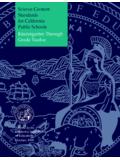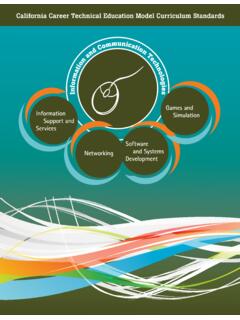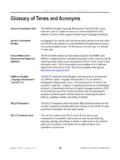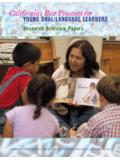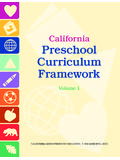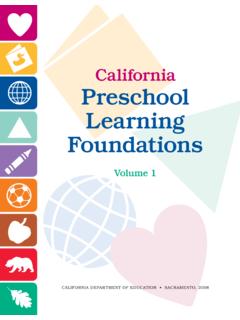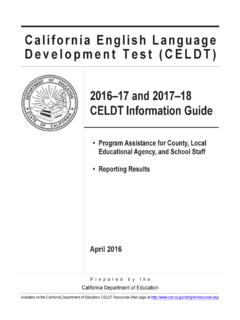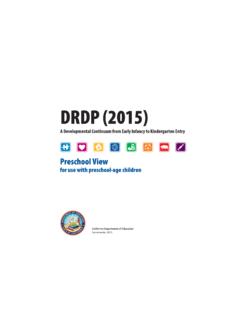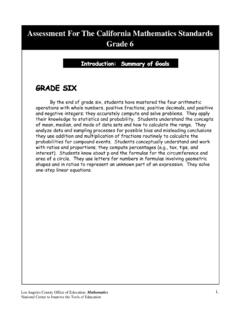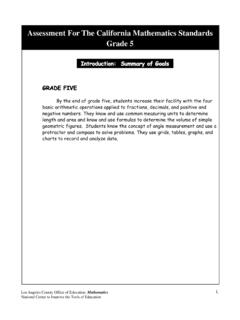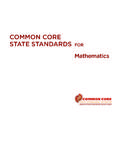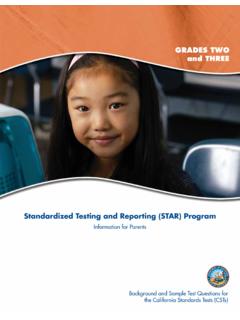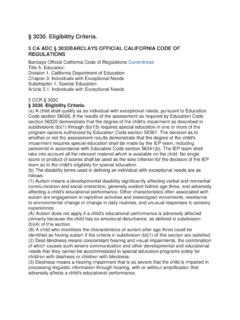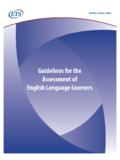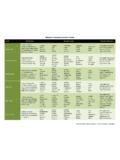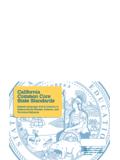Transcription of Standards Arranged by Grade Three Disciplinary Core Ideas
1 Grade Three42 | Grade -Level StandardsGrade ThreeStandards Arranged by Disciplinary core IdeasCalifornia department of EducationClarification statements were created by the writers of NGSS to supply examples or additional clarification to the performance expectations and assessment boundary statements.* The performance expectations marked with anasterisk integrate traditional science content withengineering through a Practice or DisciplinaryCore section titled Disciplinary core Ideas is reproduced verbatim from A Framework for K 12 Science education : Practices, Crosscutting Concepts, and core Ideas .
2 Revised March From Molecules to Organisms: Structures and Processes3-LS1 From Molecules to Organisms: Structures and ProcessesStudents who demonstrate understanding can:3-LS1-1. Develop models to describe that organisms have unique and diverse life cycles but all have in common birth, growth, reproduction, and death. [Clarifica-tion Statement: Changes organisms go through during their life form a pattern.] [ assessment Boundary: assessment of plant life cycles is limited to those of flowering plants. assessment does not include details of human reproduction.]The performance expectation(s) above were developed using the following elements from the National Research Council (NRC) document A Framework for K 12 Science education :Science and Engineering PracticesDeveloping and Using ModelsModeling in 3 5 builds on K 2 experiences and progresses to building and revising simple models and using models to represent events and design solutions.
3 Develop models to describe phenomena. (3-LS1-1)Connections to Nature of ScienceScientific Knowledge is Based on Empirical Evidence Science findings are based on recognizing patterns.(3-LS1-1) Disciplinary core : Growth and Development of Organisms Reproduction is essential to the continued existenceof every kind of organism. Plants and animals haveunique and diverse life cycles. (3-LS1-1)Crosscutting ConceptsPatterns Patterns of change can be used to make predic-tions. (3-LS1-1) Grade ThreeGrade-Level Standards | 43 * The performance expectations marked with an asterisk integrate traditional science content with engineering through a Practice or Disciplinary core section titled Disciplinary core Ideas is reproduced verbatim from A Framework for K 12 Science education : Practices, Crosscutting Concepts, and core From Molecules to Organisms: Structures and ProcessesCalifornia Environmental Principles and Concepts aligned to the CA NGSS:(3-LS1-1)Principle III.
4 Natural systems proceed through cycles that humans depend upon, benefit from, and can to other DCIs in third Grade : N/AArticulation of DCIs across Grade -bands: (3-LS1-1) california Common core State Standards Connections:ELA/Literacy Use information gained from illustrations ( , maps, photographs) and the words in a text to demonstrate understanding of the text ( , where, when, why,and how key events occur). (3-LS1-1) Create engaging audio recordings of stories or poems that demonstrate fluid reading at an understandable pace; add visual displays when appropriate toemphasize or enhance certain facts or details.
5 (3-LS1-1) Mathematics Model with mathematics. (3-LS1-1) 3 Use place value understanding and properties of operations to perform multi-digit arithmetic. (3-LS1-1) 3 Develop understanding of fractions as numbers. (3-LS1-1)44 | Grade -Level StandardsGrade Three * The performance expectations marked with an asterisk integrate traditional science content with engineering through a Practice or Disciplinary core section titled Disciplinary core Ideas is reproduced verbatim from A Framework for K 12 Science education : Practices, Crosscutting Concepts, and core Ecosystems: Interactions, Energy, and Dynamics3-LS2 Ecosystems: Interactions, Energy, and DynamicsStudents who demonstrate understanding can:3-LS2-1.
6 Construct an argument that some animals form groups that help members performance expectation(s) above were developed using the following elements from the NRC document A Framework for K 12 Science education :Science and Engineering PracticesEngaging in Argument from EvidenceEngaging in argument from evidence in 3 5 builds on K 2 experiences and progresses to critiquing the sci-entific explanations or solutions proposed by peers by citing relevant evidence about the natural and designed world(s). Construct an argument with evidence, data, and/ora model. (3-LS2-1) Disciplinary core : Social Interactions and Group Behavior Being part of a group helps animals obtain food,defend themselves, and cope with changes.
7 Groupsmay serve different functions and vary dramaticallyin size. (Note: Moved from K 2.) (3-LS2-1)Crosscutting ConceptsCause and Effect Cause and effect relationships are routinely identi-fied and used to explain change. (3-LS2-1)Connections to other DCIs in third Grade : N/AArticulation of DCIs across Grade -bands: (3-LS2-1); (3-LS2-1) california Common core State Standards Connections:ELA/Literacy Ask and answer questions to demonstrate understanding of a text, referring explicitly to the text as the basis for the answers. (3-LS2-1)Describe the relationship between a series of historical events, scientific Ideas or concepts, or steps in technical procedures in a text, using language that pertains to time, sequence, and cause/effect.
8 (3-LS2-1) dWrite opinion pieces on topics or texts, supporting a point of view with reasons. (3-LS2-1) information from experiences or gather information from print and digital sources; take brief notes on sources and sort evidence into provided catego-ries. (3-LS4-1)Mathematics Model with mathematics. (3-LS2-1) 3 Use place value understanding and properties of operations to perform multi-digit arithmetic. (3-LS2-1) Grade ThreeGrade-Level Standards | 45 * The performance expectations marked with an asterisk integrate traditional science content with engineering through a Practice or Disciplinary core section titled Disciplinary core Ideas is reproduced verbatim from A Framework for K 12 Science education : Practices, Crosscutting Concepts, and core Heredity: Inheritance and Variation of Traits3-LS3 Heredity: Inheritance and Variation of TraitsStudents who demonstrate understanding can:3-LS3-1.
9 Analyze and interpret data to provide evidence that plants and animals have traits inherited from parents and that variation of these traits exists in a group of similar organisms. [Clarification Statement: Patterns are the similarities and differences in traits shared between offspring and their parents, or among siblings. Emphasis is on organisms other than humans.] [ assessment Boundary: assessment does not include genetic mechanisms of inheritance and prediction of traits. assessment is limited to non-human examples.]3-LS3-2. Use evidence to support the explanation that traits can be influenced by the environment.
10 [Clarification Statement: Examples of the environment affecting a trait could include normally tall plants grown with insufficient water are stunted; and a pet dog that is given too much food and little exercise may become overweight.]The performance expectation(s) above were developed using the following elements from the NRC document A Framework for K 12 Science education :Science and Engineering PracticesAnalyzing and Interpreting DataAnalyzing data in 3 5 builds on K 2 experiences and progresses to introducing quantitative approaches to collecting data and conducting multiple trials of quali-tative possible and feasible, digital tools should be used.

